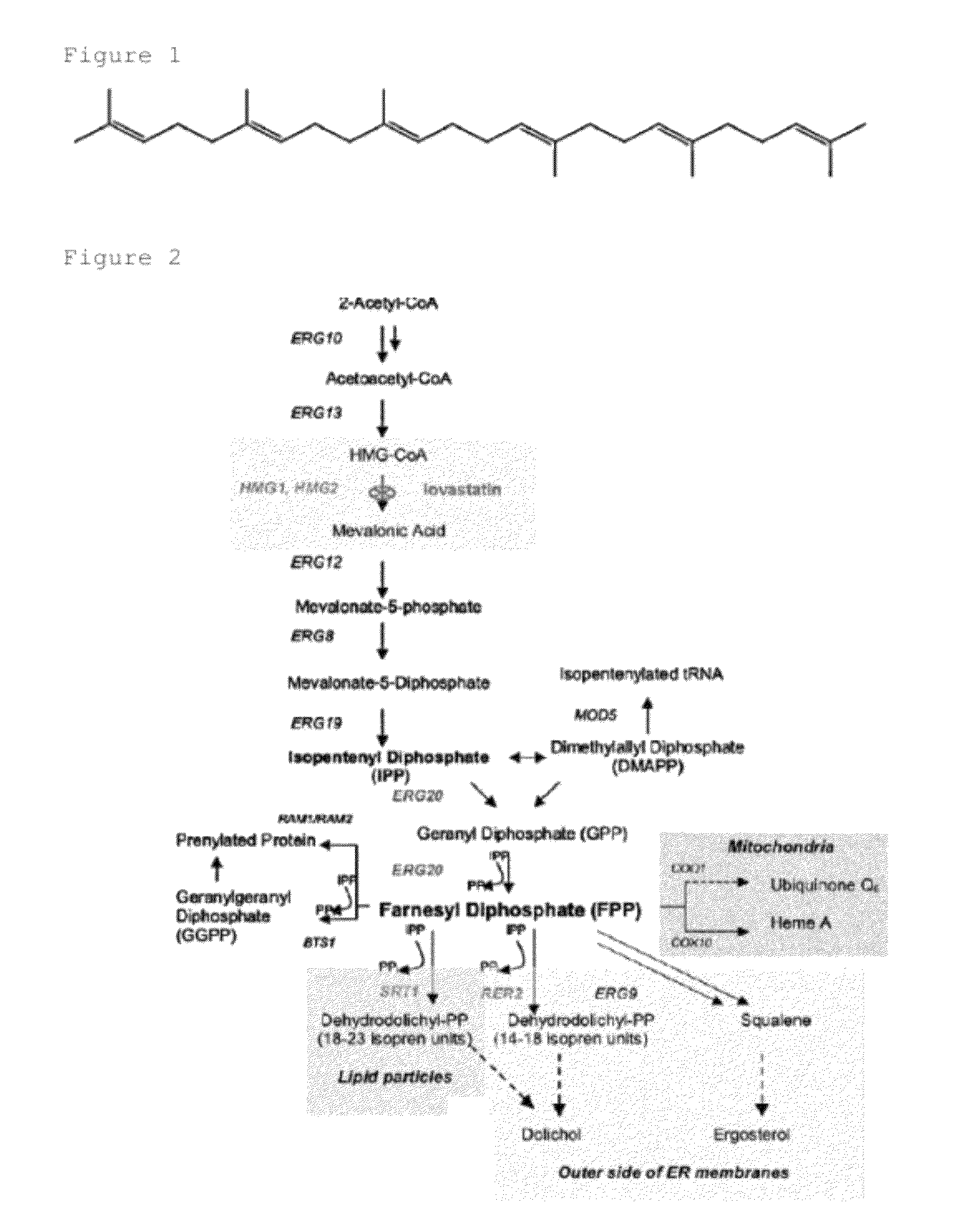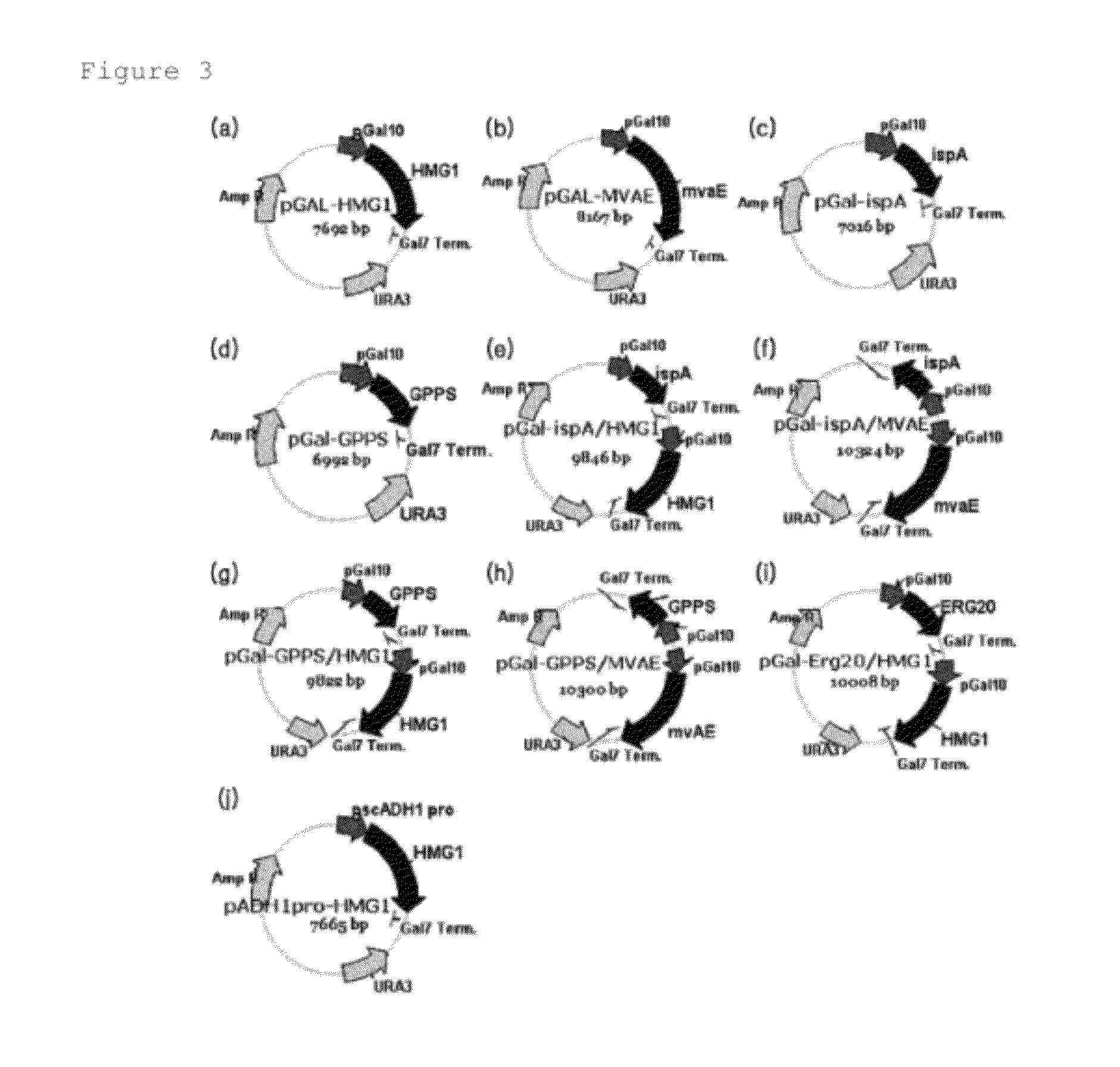Modified yeast strain and a method for producing squalene using the same
a technology of squalene and yeast, which is applied in the direction of biochemistry apparatus and processes, microorganisms, enzymes, etc., can solve the problems of insufficient commercialization productivity, continuous supply of liver oil, and insufficient supply of plant seed oil, so as to reduce the high price of squalene and high production costs. , the effect of high efficiency
- Summary
- Abstract
- Description
- Claims
- Application Information
AI Technical Summary
Benefits of technology
Problems solved by technology
Method used
Image
Examples
example 1
Construction of Squalene-Producing Strain
[0046]In order to produce squalene with high efficiency in the yeast strain Saccharomyces cerevisiae, overexpression of the genes responsible for isoprenoid biosynthetic pathway including HMG CoA reductase is required. Thus, the various genes of the isoprenoid biosynthetic pathway, expected to be involved in squalene synthesis, were cloned into yeast expression vectors (FIG. 3).
[0047]Firstly, the Enterococcus faecalis-derived bifunctional enzyme, and the MVAE gene having both acetyl-CoA acetyl transferase / hydroxymethyl glutaryl (HMG)-CoA reductase activities were artificially synthesized by GenScript Corp with a yeast codon bias (SEQ ID NO. 2), and the 5′- and 3′-ends thereof were constructed to have the EcoRI and SalI recognition sites. The gene was cleaved with EcoRI and SalI, and inserted into an expression vector YEGα-HIR525 that was treated with the same restriction enzymes. The expression vector is a vector having the GAL10 promoter, an...
example 2
Strain Culture and Squalene Analysis
[0054]The cultivation was divided into initial cultivation and main cultivation. In the initial cultivation, YNB media was used. The YNB media was supplemented with 0.67% yeast nitrogen base W / O amino acids, 0.2% casamino Acid, and 2% glucose. A single colony was inoculated in 2 ml of YNB media, and initial cultivation was performed at 30° C., 180 rpm, followed by main cultivation. The main cultivation was performed using YPGlu1% Gal1% media (2% peptone, 1% yeast extract, 1% glucose, 1% galactose). Each 25 ml of YPGlu1% Gal1% media was put in a 250 ml baffled flask. The cultured strain was inoculated to show OD600 of 0.1, and cultured at 30° C. with shaking (180 rpm). After 72 hours, the produced squalene content in the strain was measured by GC (gas chromatography).
[0055]The squalene was analyzed as follows: 1 ml of culture broth was taken and centrifuged at 13,000 rpm for 1 minute to collect the cells. The cells were resuspended in 600 μl of 50 ...
example 3
Overexpression Effects of HMG1 Gene on Squalene Productivity
[0057]Firstly, overexpression effects of the HMG1 gene, which is known to be the most important rate-determining step in the biosynthesis of isoprenoids such as squalene, on squalene productivity, were examined.
[0058]In order to examine the effect on squalene productivity according to the differences among the strains and the promoter activities of expression vectors therefrom, Saccharomyces cerevisiae Y2805 strain was used together with Saccharomyces cerevisiae W303 and YPH499 strains (Tokuhiro K. et al., Appl. Environ. Microbiol. 75, 5536-5543 (2009)) commonly used as host cells for gene expression, with combinations of the GAL10 promoter or the ADH1 promoter (Table 3).
[0059]
TABLE 3DCW(Dry cellSqualeneSqualeneweight,(mg / gStrainVector(g / l)OD600g / l)DCW)Y2805—0.003229.18.470.4Y2805pGal-HMG10.45021.66.2671.9Y2805pADH1-HMG10.48419.45.6386.0W303—0.000121.16.120.0W303pGal-HMG10.00614.34.151.4W303pADH1-HMG10.001219.05.510.2YPH499...
PUM
| Property | Measurement | Unit |
|---|---|---|
| pH | aaaaa | aaaaa |
| size | aaaaa | aaaaa |
| antioxidant | aaaaa | aaaaa |
Abstract
Description
Claims
Application Information
 Login to View More
Login to View More - R&D
- Intellectual Property
- Life Sciences
- Materials
- Tech Scout
- Unparalleled Data Quality
- Higher Quality Content
- 60% Fewer Hallucinations
Browse by: Latest US Patents, China's latest patents, Technical Efficacy Thesaurus, Application Domain, Technology Topic, Popular Technical Reports.
© 2025 PatSnap. All rights reserved.Legal|Privacy policy|Modern Slavery Act Transparency Statement|Sitemap|About US| Contact US: help@patsnap.com



